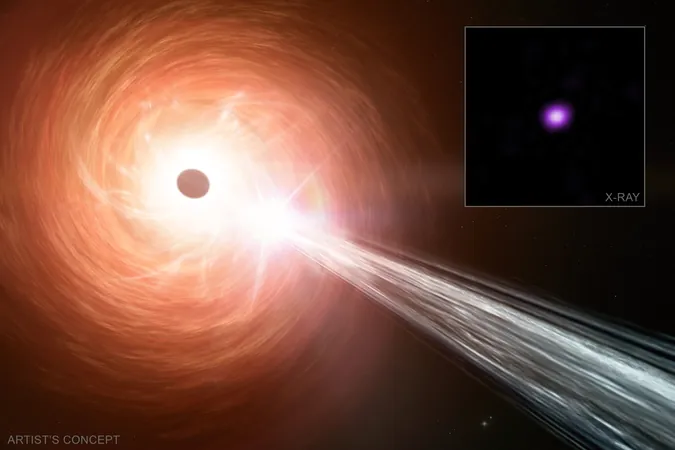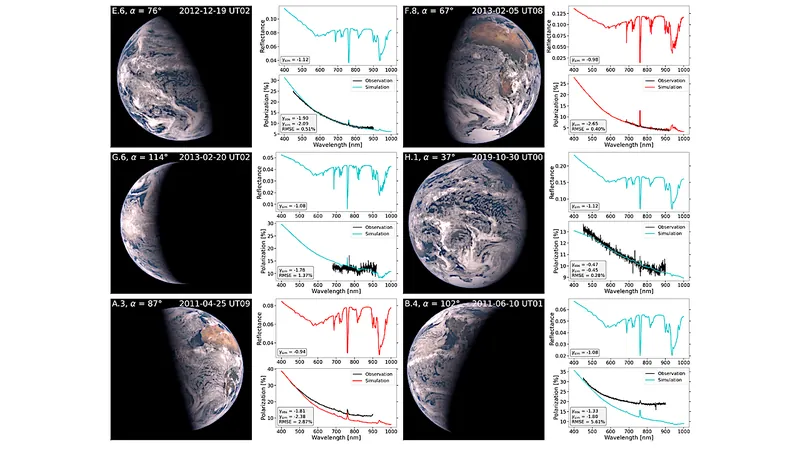
Astounding Discovery: Black Hole Growing at an Unprecedented Rate!
2025-09-19
Author: Charlotte
Astronomers Uncover Record-Breaking Black Hole
In a jaw-dropping revelation, astronomers have spotted a black hole expanding faster than anyone could have imagined! Thanks to NASA's Chandra X-ray Observatory, this remarkable finding sheds light on how black holes could amass incredible masses shortly after the Big Bang.
Meet the Behemoth Black Hole
This colossal black hole, boasting a mass equivalent to a staggering billion suns, is situated an astonishing 12.8 billion light-years away from Earth. This distance means we’re witnessing a cosmic event that occurred just 920 million years after the universe took its first breath. Strikingly, it emits more X-rays than any other black hole observed during the universe’s infancy!
The Quasar Powering This Giant
This formidable black hole powers a quasar—a brilliant entity that shines brighter than entire galaxies! The intense glow is fueled by a vast torrent of matter spiraling into the black hole, creating one of the universe's most dazzling spectacles.
A Shocking Growth Rate!
Discovered two years ago, further analysis in 2023 revealed that this quasar, designated RACS J0320-35, is growing at a shocking rate that surpasses what’s deemed normal. "It was a bit shocking to see this black hole growing by leaps and bounds," commented lead study author Luca Ighina from the Center for Astrophysics | Harvard & Smithsonian.
Understanding the Eddington Limit
As matter gets pulled into a black hole, it heats up, emitting intense radiation—including X-rays—creating a pressure that counters the black hole's gravity. When this balance reaches a peak (the Eddington limit), typically, growth slows. However, RACS J0320-35 is defying these norms!
A Unique Formation Process?
The prevailing theory suggests that black holes growing slower than the Eddington limit likely started with masses more than 10,000 suns. Yet, if RACS J0320-35 is indeed growing 2.4 times faster than this limit, it might have initially formed through different means—perhaps collapsing from a massive star.
Piecing Together the Puzzle
Co-author Alberto Moretti explains, "By understanding the black hole's mass and growth rate, we can speculate on its potential birth size." Researchers utilized Chandra’s X-ray spectrum to discern its rapid growth, finding significant support from optical and infrared data.
Chasing Cosmic Mysteries
With this discovery, scientists are closer to unraveling the mysteries surrounding the early universe’s black hole formation. Co-author Thomas Connor emphasized, "How did the universe create the first generation of black holes? This question remains pivotal in astrophysics, and RACS J0320-35 is a key to unlocking potential answers."
The Mystery of Particle Jets
Another intriguing aspect of RACS J0320-35 is its emission of particle jets traveling close to the speed of light. Such jets are typically scarce in quasars, hinting that the black hole's outstanding growth might be involved in their formation.
Tools Behind the Discovery
This dazzling quasar was initially discovered through the Australian Square Kilometer Array Pathfinder survey, in conjunction with data from the Dark Energy Camera and the Gemini-South Telescope in Chile, aiding in determining its impressive distance.









 Brasil (PT)
Brasil (PT)
 Canada (EN)
Canada (EN)
 Chile (ES)
Chile (ES)
 Česko (CS)
Česko (CS)
 대한민국 (KO)
대한민국 (KO)
 España (ES)
España (ES)
 France (FR)
France (FR)
 Hong Kong (EN)
Hong Kong (EN)
 Italia (IT)
Italia (IT)
 日本 (JA)
日本 (JA)
 Magyarország (HU)
Magyarország (HU)
 Norge (NO)
Norge (NO)
 Polska (PL)
Polska (PL)
 Schweiz (DE)
Schweiz (DE)
 Singapore (EN)
Singapore (EN)
 Sverige (SV)
Sverige (SV)
 Suomi (FI)
Suomi (FI)
 Türkiye (TR)
Türkiye (TR)
 الإمارات العربية المتحدة (AR)
الإمارات العربية المتحدة (AR)